Ah, the humble ukulele. Regularly underestimated. All too often out of sight, out of mind. An impulse purchase or forgotten Christmas gift that’s been stashed under the bed and left to collect dust.
The ukulele is an incredibly versatile instrument however, not simply limited to featuring in Hawaiian Luaus and lazy renditions of Somewhere Over The Rainbow.
Part of its appeal is its charming timbre, like the newborn baby of a classical guitar and a harp. A second reason for their popularity (even if short lived in the hands of the buyer) is their attractively low prices. You can pick up a decent uke for well under $50.
Last but not least though is the fact that they are seriously easy to play. The fact that they have only four strings helps some, but it’s the tuning of the strings that makes things ridiculously simple. Two chords (Am and C) require just one finger to play, with many others use just two or three.
And, once you’ve mastered those stupendously easy chords, you’ve got a plethora of popular songs to add to your repertoire. We’re going to explore a few shortly, but before we do, there’s a couple of tricks you need to know.
Contents
- Ukuleles Aren’t Actually Hawaiian
- Using A Capo
- The Four Chords You Absolutely Have To Know On The Ukulele
- C Major Ukulele Chord
- A Minor Ukulele Chord
- F Major Ukulele Chord
- G Major Ukulele Chord
- 10 Songs Using Just Four Chords
- Rude – Magic
- What Makes You Beautiful – One Direction
- You’re Beautiful – James Blunt
- Hey Soul Sister – Train
- I’m Yours – Jason Mraz
- All Along the Watchtower – Bob Dylan/Jimi Hendrix
- Just The Way You Are – Bruno Mars
- Counting Stars – One Republic
- Whistle – Flo Rida
- One Love – Bob Marley
- A Few More Chords To Master
- E Major Ukulele Chord
- D Major Ukulele Chord
- D Minor Ukulele Chord
- D7 Ukulele Chord
- A Major Ukulele Chord
- Somewhere Over the Rainbow / Wonderful World – Israël Kamakawiwo’ole
- Someone Like You – Adele
- Hallelujah – Leonard Cohen/Jeff Buckley
- Otherside – Red Hot Chili Peppers
- Love Yourself – Justin Beiber
- I Will Wait – Mumford and Sons
- Let it Go – Frozen
- Conclusion
Ukuleles Aren’t Actually Hawaiian
Okay maybe this isn’t a “need to know”, but it’s interesting nonetheless.
Though they do feature heavily in Hawaiian music, and regularly appear at family gatherings, luaus, and lazy weekends on the beach, the ukulele isn’t actually from this glorious archipelago. In fact, Portugal holds the rights as the home country of the humble uke.
Essentially an evolved version of the Portuguese machête, the ukulele was originally invented in Madeira, a once-popular tourist spot off the southwest coast of Portugal. This all changed in the 1870s, and luckily, Hawaii’s sugar plantations were looking for workers. So, a few thousand jobless Portuguese headed over to Oahu and took their instruments with them.
Eventually they finished up with their sugar company contrasts, and a few of them opened up a musical instrument shop in Honolulu. The rest, as they say, is history.
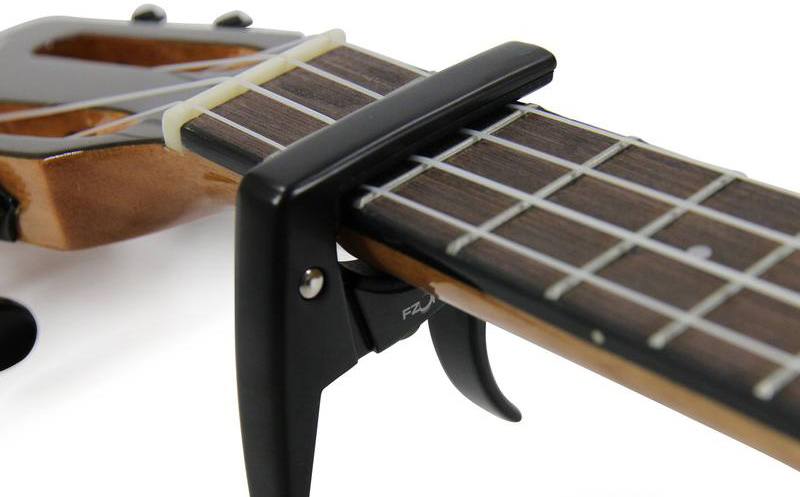
Using A Capo
It’s not unusual to see many ukulele players using a capo on their fretboard. This is a fairly common technique that makes life a little bit easier. Playing the ukulele is all about simplicity, so why not keep things simple where you can.
A capo is a device that clips onto the fretboard of a stringed instrument (like a guitar or a ukulele), and alters the tuning of the instrument.
It’s like having an extra finger barring all four strings on your ukulele, and it changes the tuning of the strings so you can play the same shapes, but have access to different chords. For example, if you have the capo on the 2nd fret and play a C shape, you’ll have a D.
Of course, you can still play a D chord without a capo, and the beauty of the ukulele is that it’s incredibly easy to play all four strings at once. This just makes things a little bit easier, especially if you’re playing a song that uses only three or four chords and you don’t need to access lower down on the fretboard.
The Four Chords You Absolutely Have To Know On The Ukulele
Once you’ve learned these four simple chords, you’ll be set to play literally hundreds of songs. Especially if you have access to a capo, as many songs use the same progressions but in different keys.
C Major Ukulele Chord
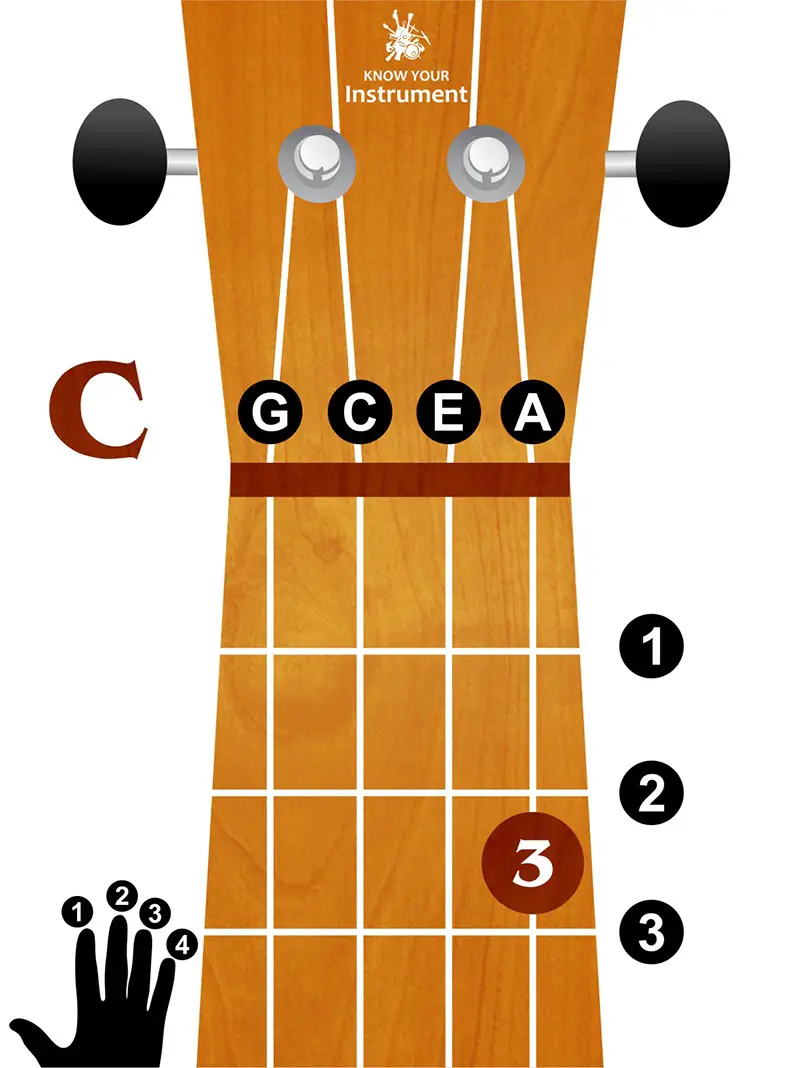
A Minor Ukulele Chord
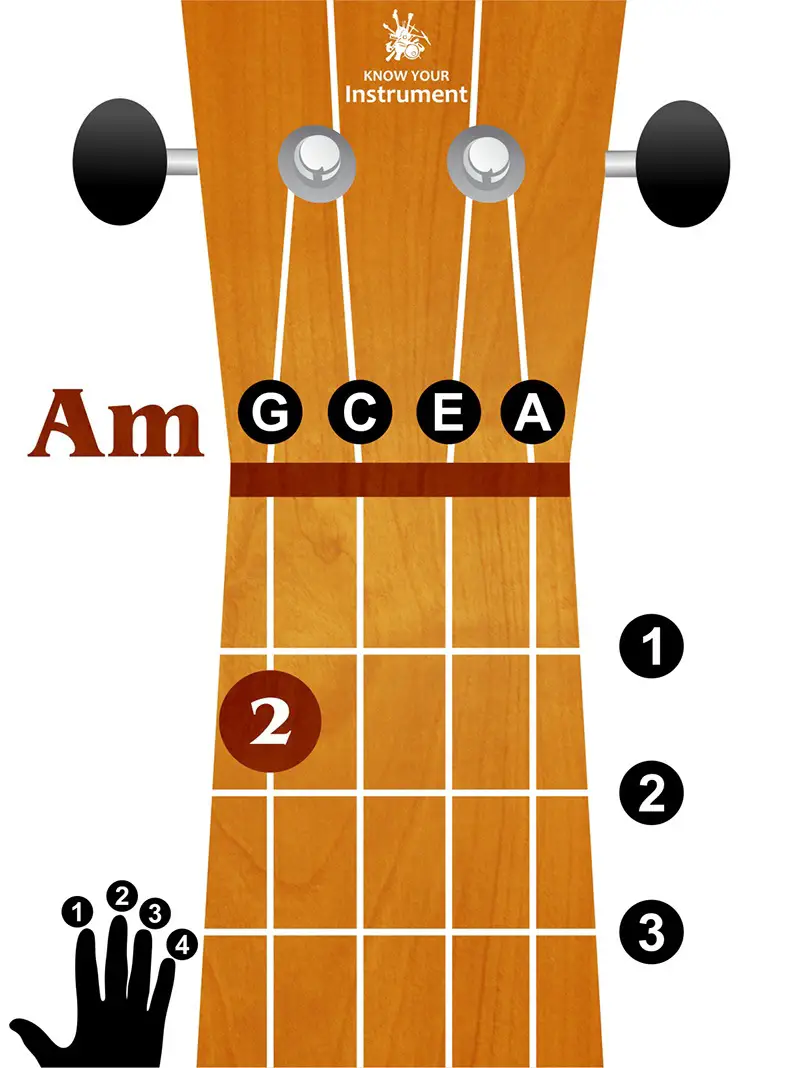
F Major Ukulele Chord
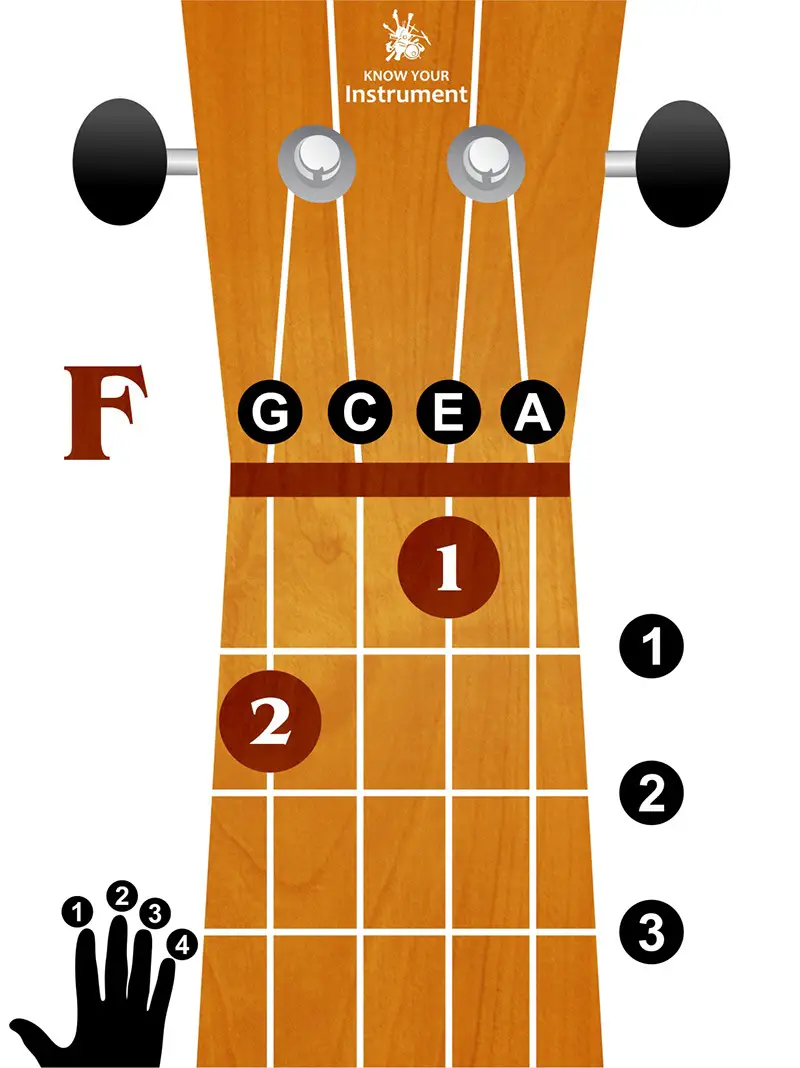
G Major Ukulele Chord
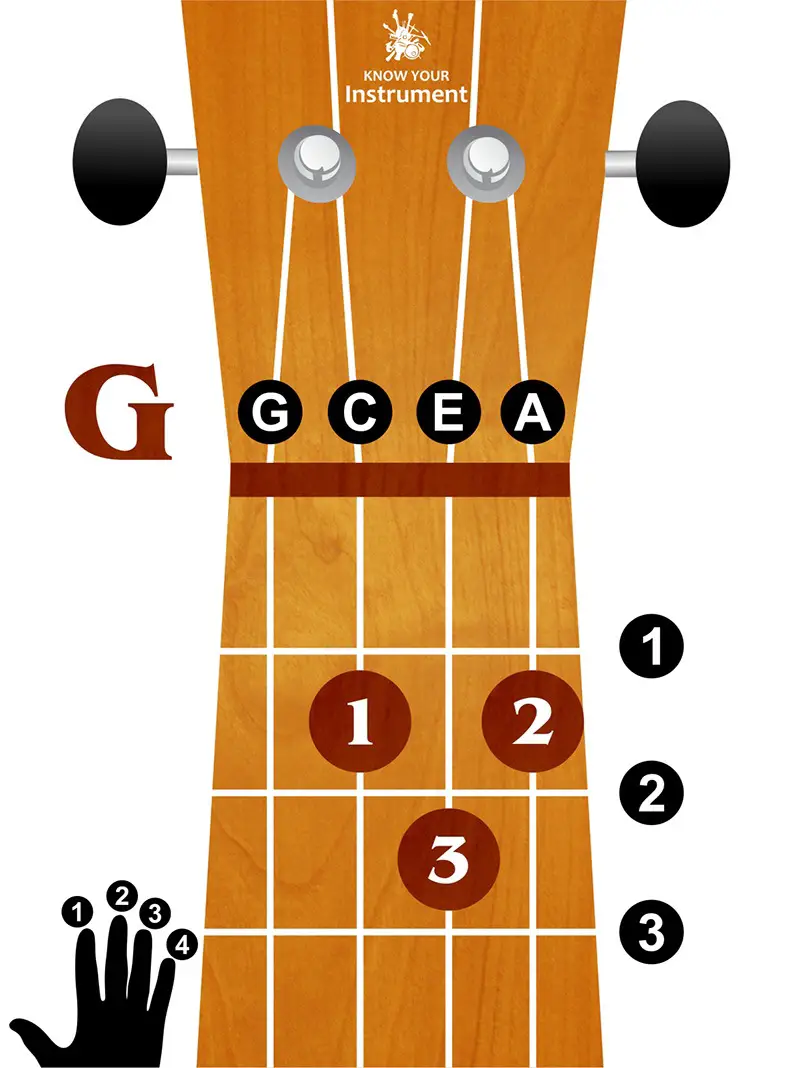
10 Songs Using Just Four Chords
There are a lot of songs you can play with just C, G, F, and Am. I mean, a lot. Get your capo out and let’s get into it…
Rude – Magic
As if using just four chords wasn’t easy enough, this song pretty much plays the same chord progression all the way through.
The verse has two iterations of F-G-C-C, then two iterations of F-G-C-Am. From there, the pre-chorus and chorus are the same as the second half of the verse: F-G-C-Am.
You can’t go wrong with the song structure either: Verse, Pre-Chorus, Chorus (x2), then instrumental (same as verse), Pre-Chorus, Chorus. Simple. Oh, you’ll want to get your capo out for this one, and clip it on the first fret.
What Makes You Beautiful – One Direction
This was a pretty polarizing tune when it came out, now it’s a bit of a modern classic. Hey, I said “a bit”.
With your capo on the fourth fret, you’ll only need three chords for this one: C, F, and G. Play them in that order for the verse, pre-chorus, and chorus. Seriously. It’s that easy.
You’re Beautiful – James Blunt
If she didn’t get the hint when you played that last song, try this one. And try staring straight into her eyes while you do it. If it doesn’t absolutely creep her out then you’ve got a shot.
You’ll need all four chords for this one; you can put the capo away for now though. The verse follows a pretty simple progression: C, G, Am, F. Play that twice. The chorus changes it up a little though. Two repeats of F-G-C-C, two of F-G-C-Am, then one more F-G-C to finish (“Cause I’ll never be with you”).
After a second run-through of the verse and chorus progressions, you’ve got the bridge (“la-la-la”) which goes: F-C-F-C-F-C-G, then one more chorus to finish.
Hey Soul Sister – Train
This hit hails back to 2009, and was even covered by the cast of Glee at one point. Yeah, remember Glee?
You can go straight into this one from “What Makes You Beautiful” if you like, keeping your capo on the fourth fret.
The verses are pretty simple: C-G-Am-F, then C-G-Am-G. Repeat that twice, then head into the chorus:
F-G-C-G-F
“Hey soul sister ain’t that Mister Mister on the radio stereo”
G-C-G
“The way you move ain’t fair you know”
F-G-C-G-F-G
“Hey soul sister I don’t want to miss a single thing you do”
The post-chorus is the same as the first half of the verse: C-G-Am-F, then you run through it all again before the outro progression of C-G-Am-F-G x2, and finishing on a C.
I’m Yours – Jason Mraz
An instantly recognizable ukulele tune, I’m Yours by Jason Mraz is a crowd favorite. Luckily, it’s pretty damn simple too.
For the verse, play C, G, Am, then F. Then play the same for the chorus, and for the interlude. Then do it all again, and play the same progression of the outro. Done and dusted.
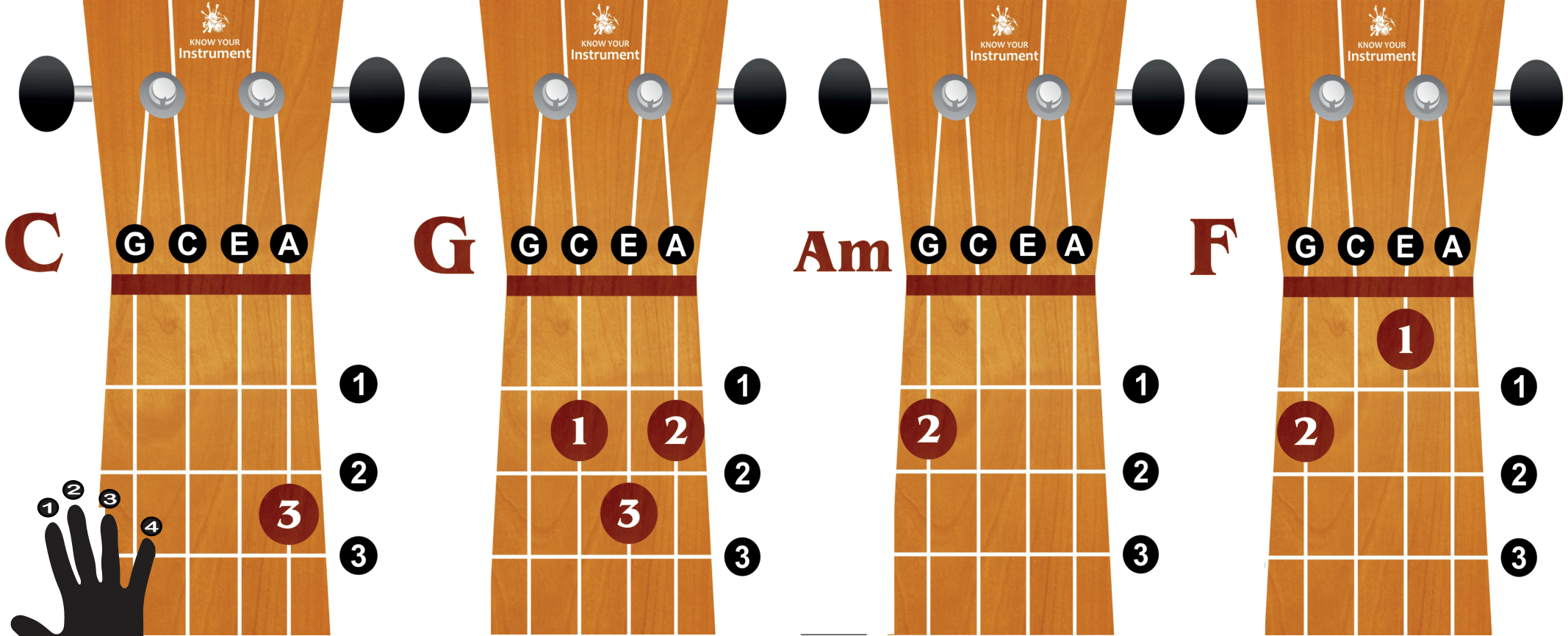
All Along the Watchtower – Bob Dylan/Jimi Hendrix
This one’s another three-chord song, following an Am-G-F-G chord progression. It pretty much follows that same progression all the way through, so once you’ve got that nailed, just rinse and repeat.
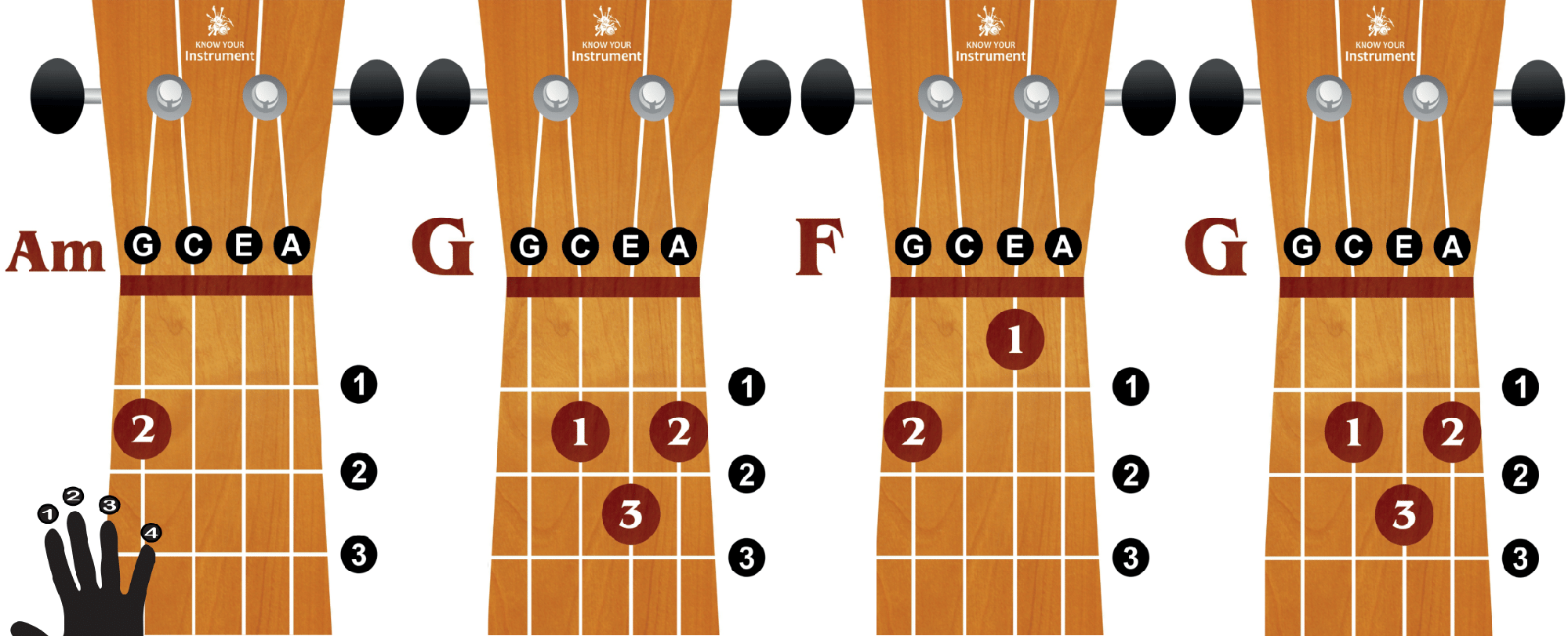
Just The Way You Are – Bruno Mars
With your capo on the 3rd fret, this is another easy tune you can play on the ukulele with only three chords.
The strumming pattern is super important on this one: 1, 2 and, and 4 and. Once you’ve got that pattern down, simply play C-Am-F-C all the way through, and you’ll have these one nailed.
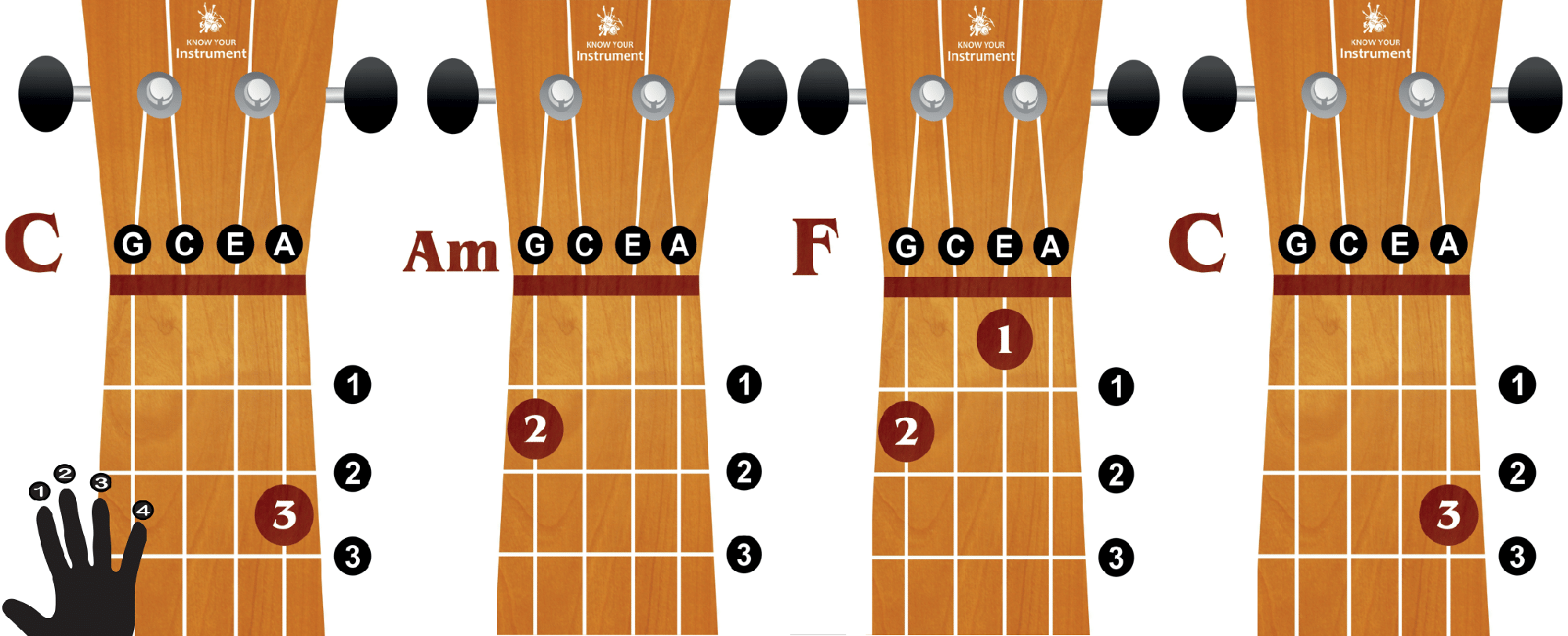
Counting Stars – One Republic
No complicated strumming pattern here, just follow a simple eight-note pattern and you’ll be sweet. The intro and verse follow an Am-C-G-F chord progression, so play that through 4x, and the two more times for the first half of the pre-chorus. The second half of the pre-chorus sits on the F chord: “I couldn’t, lie, couldn’t lie, couldn’t lie Everything that kills me makes me feel alive.”
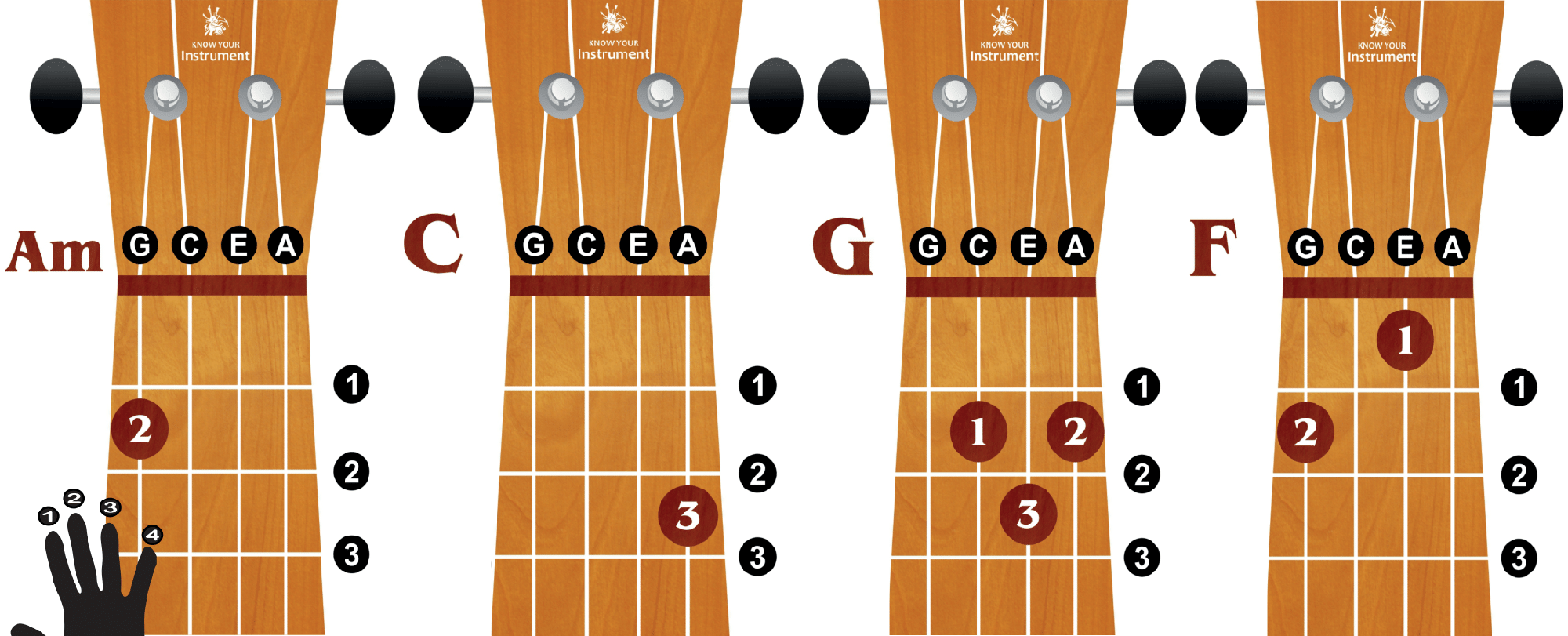
The chorus follows the same progression as the verse: Am-C-G-F. Play that through twice, followed by a vocal-only interlude, another chorus, and an outro section that follows the same chord progression as the verse and chorus.
Whistle – Flo Rida
Maybe not the first song you think of when looking for ukulele tunes, but this one’s actually super easy to learn
Starting on Am, Whistle follows a simple Am-F-C-G chord progression all the way through. So get your lips warmed up and start whistling.
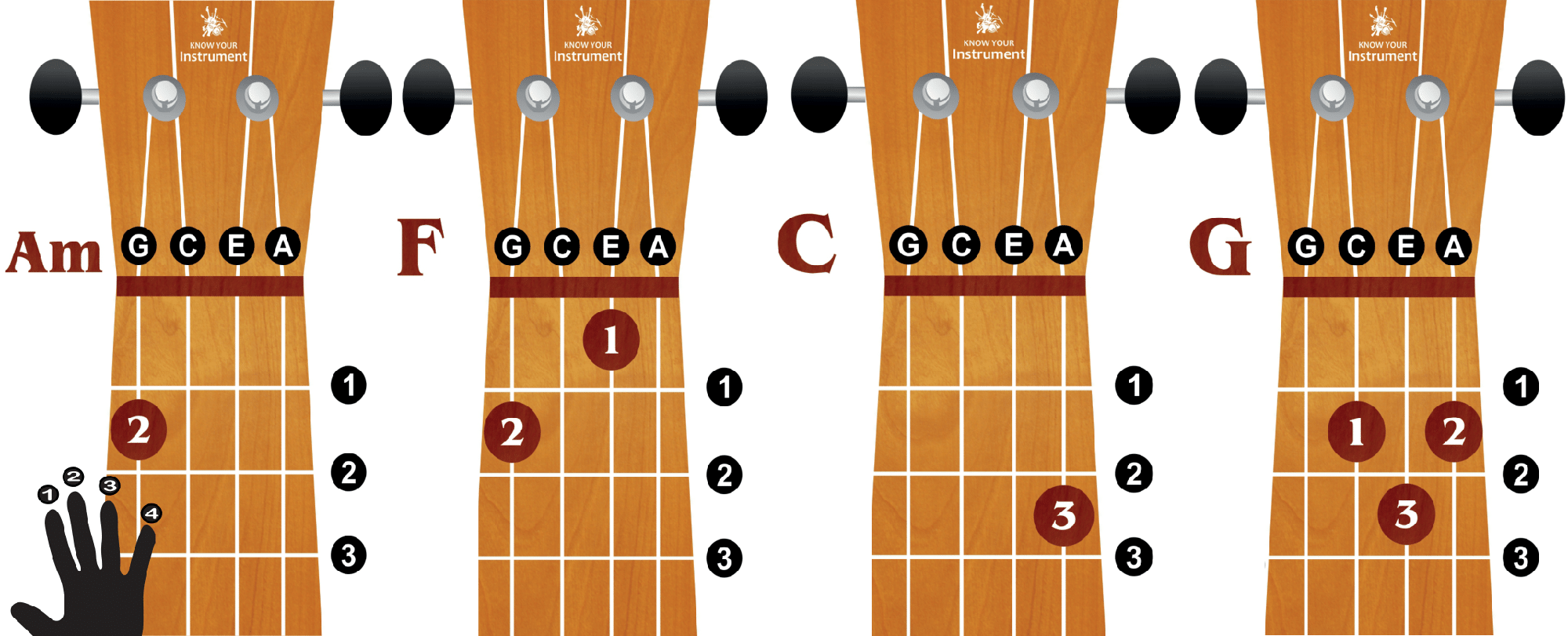
One Love – Bob Marley
Nothing beats a little Bob Marley in the sun in the afternoon, except a little Bob Marley on the uke!
The intro goes like this: C-C-G-G-F-C-G-C.
Then, the chorus follows a pretty complicated chord progression, compared to many of the songs we’ve learned so far. Start with a C and a G for “One love, One heart”. Then F-C-G-C-G, then two iterations of F-C-G-C beginning on “Sayin’”.
The verses aren’t overly straightforward either. The first line (Let them all pass all their dirty remarks (One Love!)) follows C-Am-F-C, with the second line moving to a C-Am-F-G-C progression. The second half of the chorus is the same as the first; at least that’s easy!
After you’ve played the intro, chorus, and first verse, you’ll play a second chorus, a second verse, and a third chorus, before finishing on the outro chord progression: F-C-G-C x4.
A Few More Chords To Master
Though you could keep going forever learning songs with Am, C, F and G, at some point you’re bound to get a little bored. Learning an instrument is all about challenging yourself, pushing yourself to develop and get better and better. So, in the spirit of learning and development, here are five more chords to nail on the ukulele that will open up a whole new world of songs to learn.
E Major Ukulele Chord
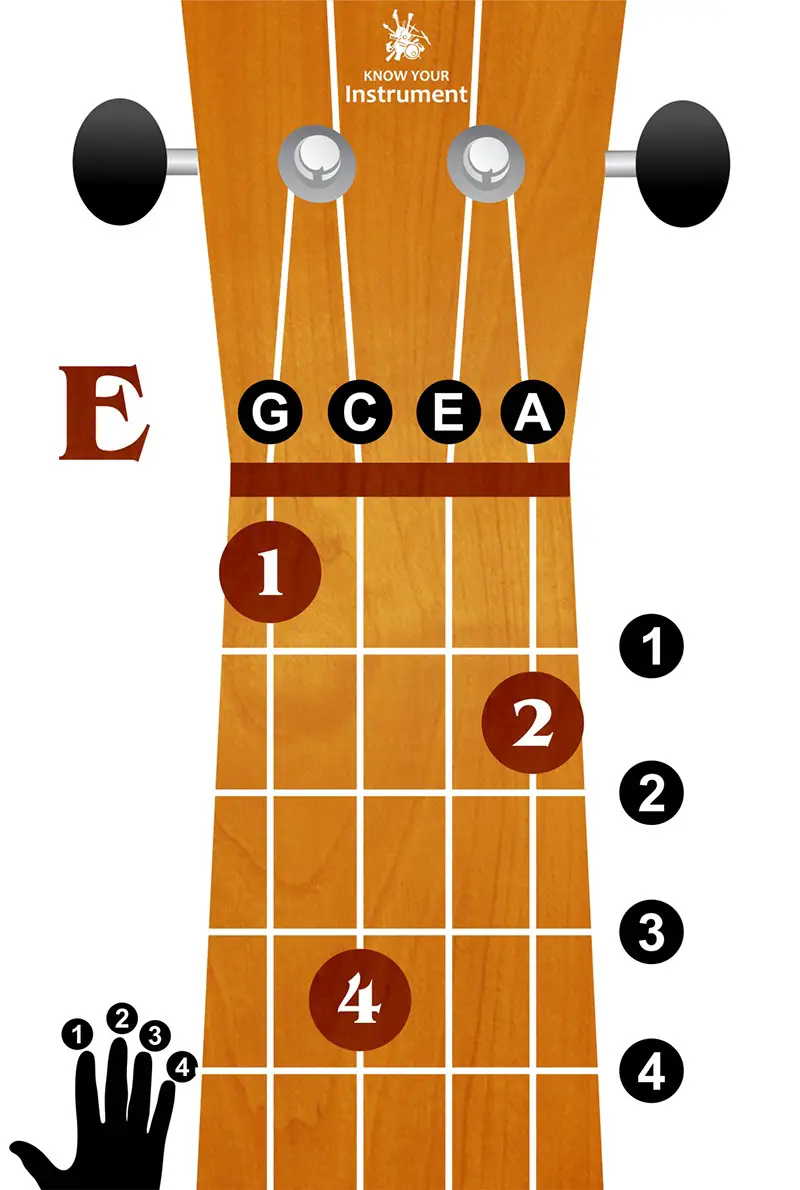
D Major Ukulele Chord
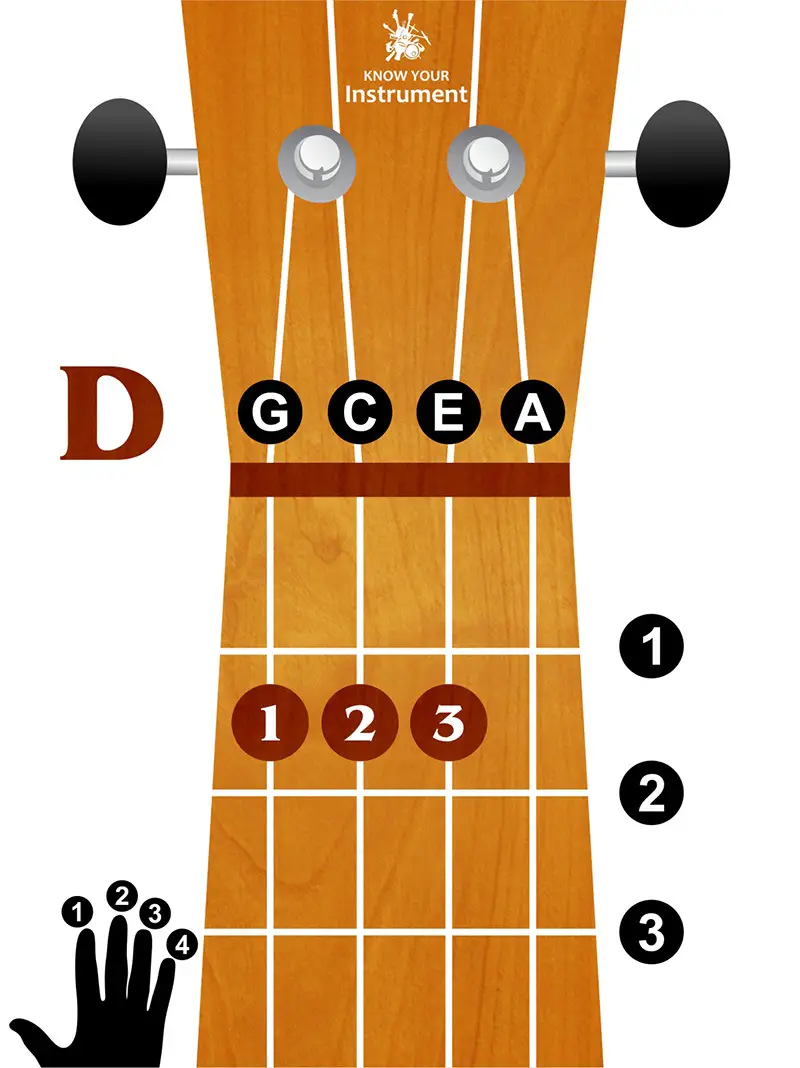
D Minor Ukulele Chord
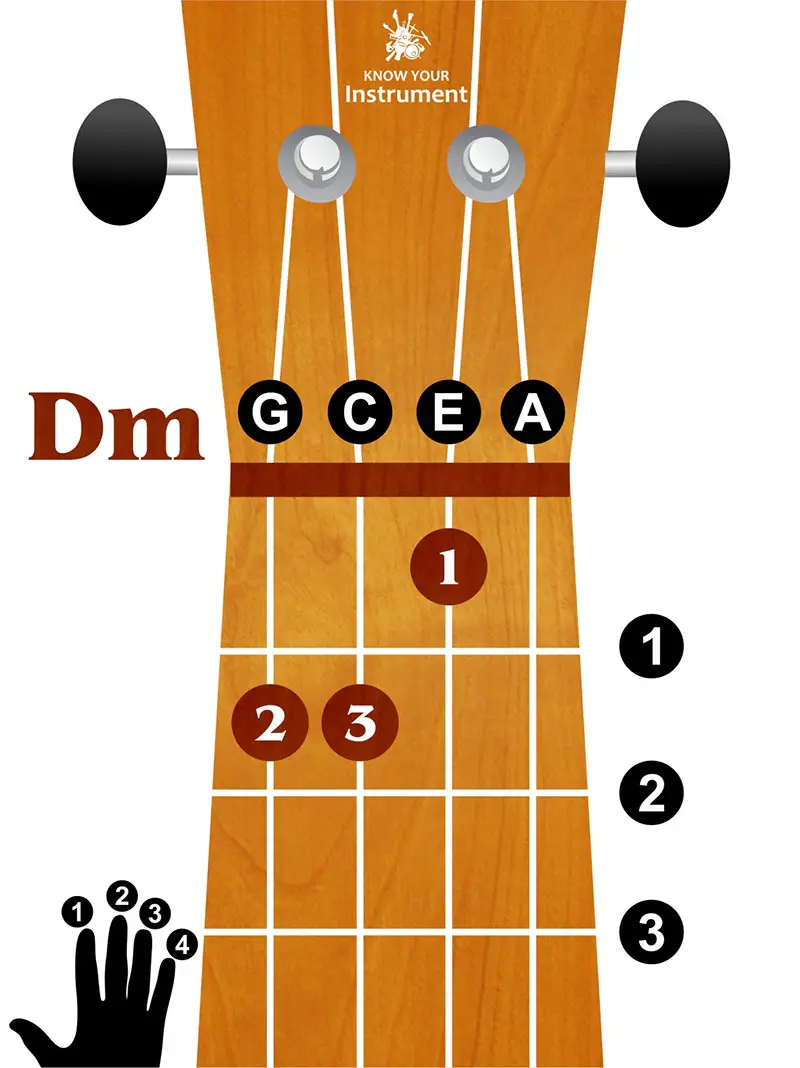
D7 Ukulele Chord
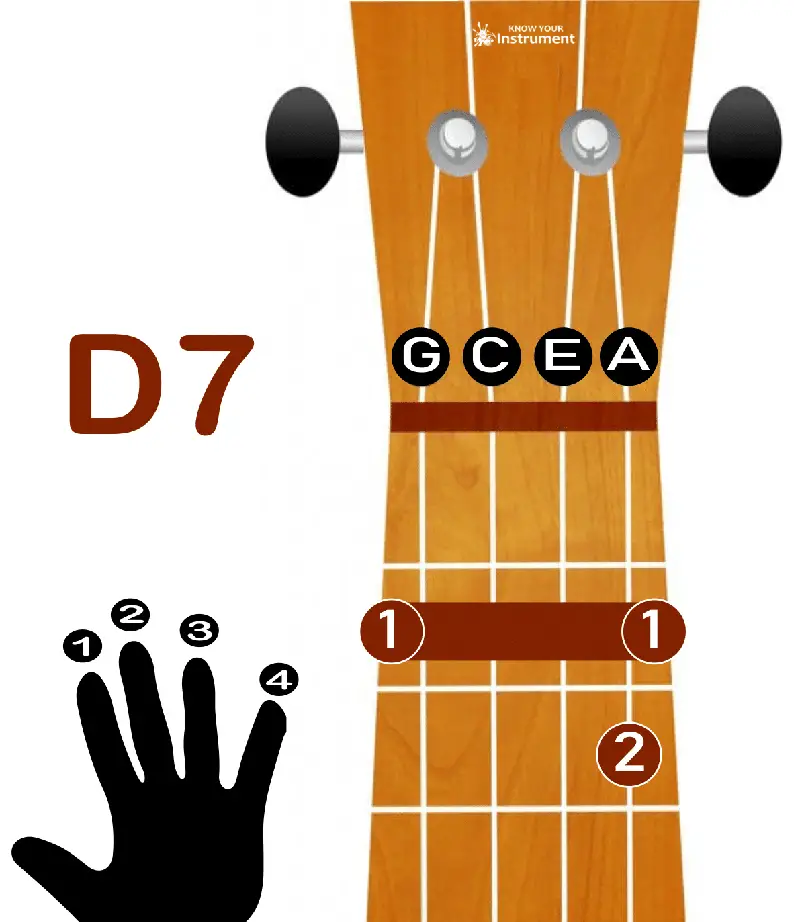
A Major Ukulele Chord
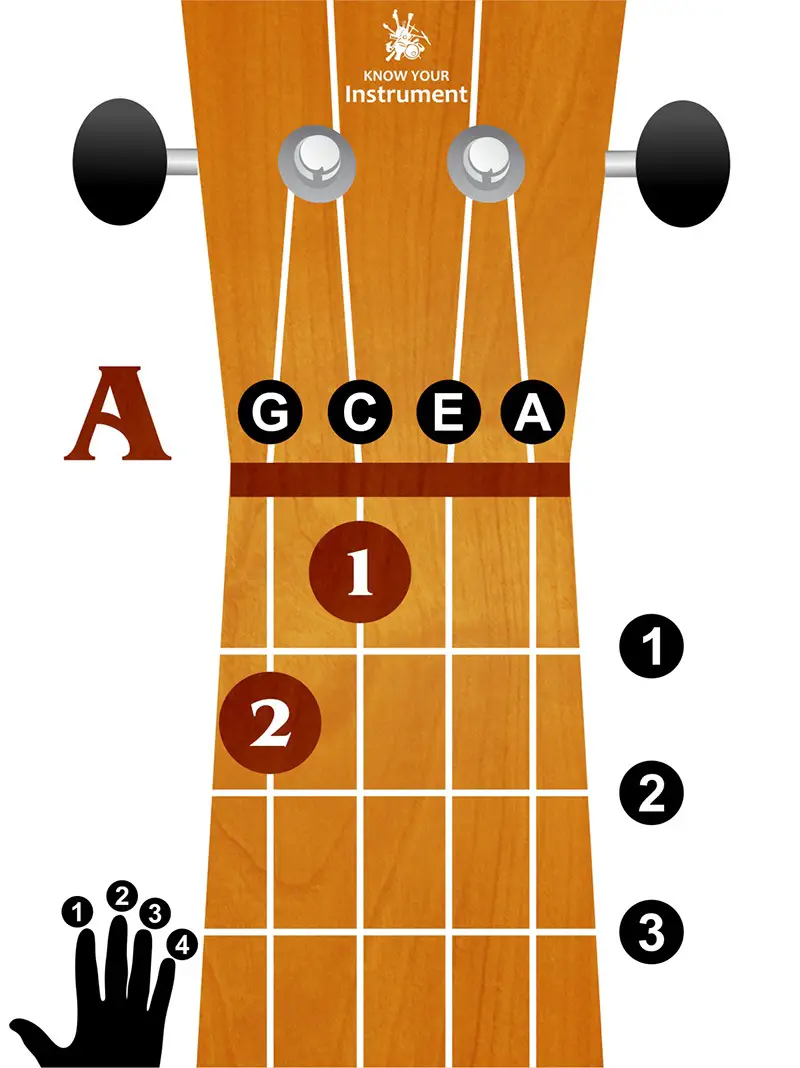
Somewhere Over the Rainbow / Wonderful World – Israël Kamakawiwo’ole
We’d be remiss if we didn’t include this somewhere on the list; this one is the epitome of classic ukulele tunes.
This song is actually a medley of two popular songs: Somewhere Over the Rainbow from the original The Wizard of Oz film and Wonderful World by Louis Armstrong.
The chord progression is pretty complex, so let’s break it down.
Intro
The first part of the intro follows this progression: C, G, Am, F, C, G, Am, Am, F, F. The second part (where the oo-s come in) of the intro changes, and follows: C, Em, F, C, F, Em, Am, F.
Chorus – Somewhere Over the Rainbow
This is the part we all know and love, and it’s best broken up into four lines. The first line (somewhere over…) goes C, Em, F, C. The second line (and the dreams…) is a little different: F, C, G, Am, F.
You then play two rounds of C, G, Am, F starting at “someday I’ll wish..”, before running through the chorus chord progression.
Wonderful World
The Wonderful World section uses the same chords, but uses a different progression.
It goes like this:
C-Em-F-C
“Well I see trees of green and Red roses too”
F-C-Em-Am
“I’ll watch them bloom for me and you”
F-G-Am-F
“And I think to myself: what a wonderful world”
C-Em-F-C
“Well I see skies of blue and I see clouds of white”
F-C-Em-Am
“And the brightness of day, I like the dark”
F-G-C-F-C
“And I think to myself: what a wonderful world”
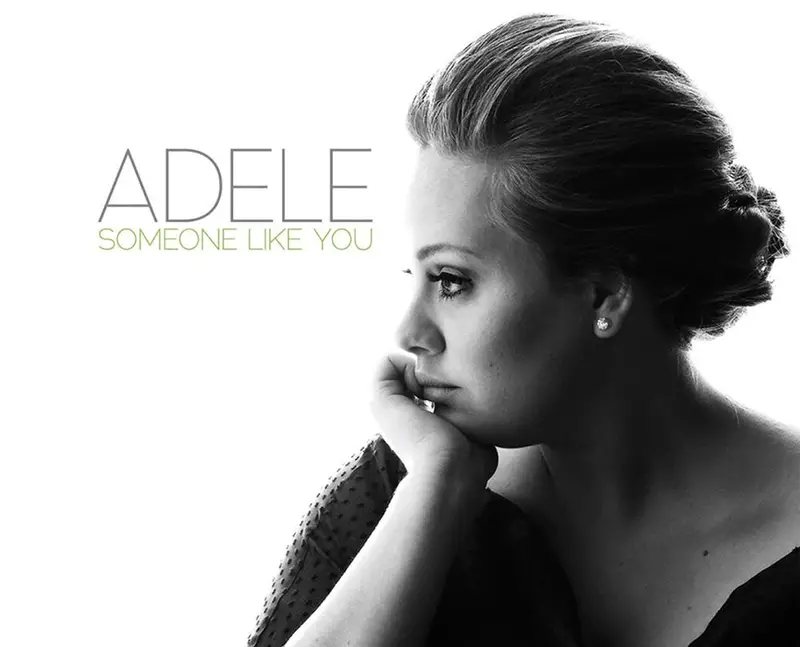
Someone Like You – Adele
Adele blew up the world with her song Someone Like You, and though it might be a tough one to sing, it’s pretty easy to play on the uke.
The verse follows a G-D-Em-C chord progression. Play that three times for the first verse, before heading into the pre-chorus (“I hate to turn up out of the blue”) with Am-C-Em-D x2.
The chorus returns to the G-D-Em-C progression, which you’ll play five times.
The second verse repeats the progression just twice, then it’s back into the chorus again. The bridge is the same as the pre-chorus, adding another C and D chord at the end to transition into the final chorus.
Hallelujah – Leonard Cohen/Jeff Buckley
Originally written by Leonard Cohen and popularized by Jeff Buckley, Hallelujah is an instantly recognizable melody which isn’t all that difficult to play.
The verses go like this: C, Am, C, Am, F, G, C, G. The pre-chorus, everyone’s favorite bit, runs through C, F, G, Am, F, G, Em, Am.
Then, the chorus is pretty simple: F, Am, F, then C, G, C, C to finish. Repeat x4.
Otherside – Red Hot Chili Peppers
Typically more of a six-strong song, Otherside actually plays pretty nicely on the ukulele, and it uses exactly the same chords as Hallelujah.
The chorus looks like this:
Am-F-C
“How long how long will I slide”
G-Am-F-C
“Separate my side I don’t”
G-Am-F
“I don’t believe it’s bad”
C-G
“Slit my throat it’s all I ever”
The verses are even easier: Am, Em x3 then G, Am. You’ll be forgiven for not learning the bassline in the bridge, so simply play Em-C-Em-C, then Am-F-C-G.
Love Yourself – Justin Beiber
Love Yourself is another fun, easy to learn song for the ukulele. Plus, you’ll get a chance to show off the D Minor.
The first follows a C, G, Am, Dm, C, G chord progression, which repeats three times. The pre-chorus plays Am, F, C three times, an Am, F, G for the fourth progression before reaching the chorus: C, G, Am, F, C, G, C x2.
The whole thing repeats three times, with no pre-chorus between the third verse and chorus.
I Will Wait – Mumford and Sons
Mumford and Sons are known for their distinctive folk rock sound, using instruments like the double bass and banjo. We’re going to beach it up a little with this ukulele rendition.
The first verse is pretty simple:
C-C-F-F
“I came home like a stone”
C-C-G-G
“And I fell heavy into your arms”
C-C-F-F
“These days of dust, which we’ve known”
C-C-G-G
“Will blow away with this new sun”
The pre-chorus is a little more complex: Am, Em, C, F, C, G, G x2. The chorus, however, is super simple: C, C, Em, G x2
Repeat three times, with the solo and bridge in between the third verse and final chorus.
Solo chord progression: C, C, Em, Am, Am, F, C, G x2
Bridge progression: C, C, Em, Am, Am, F, C ,G x2
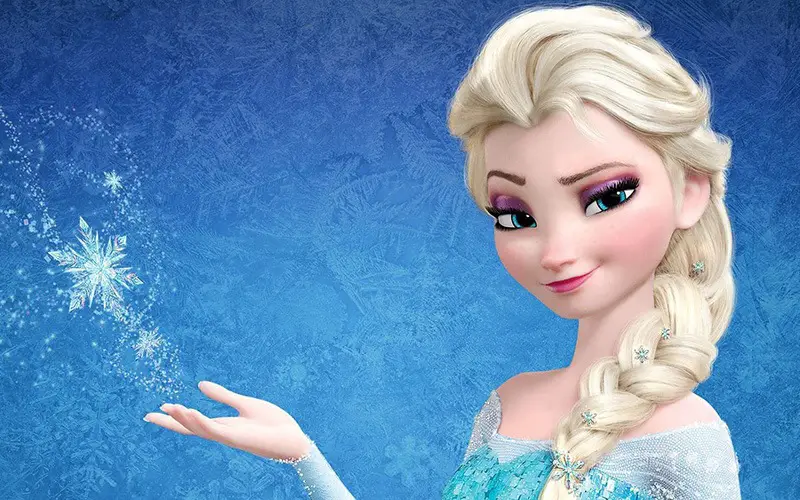
Let it Go – Frozen
If you’re a parent or teacher, you’ve probably heard this one enough times to skip it. Your kids will love you for it though…
This one uses just four chords: Em, C, G, and D.
The verses follow that exact progression (Em, C, G, D) four times. The pre-chorus is super simple too: D, C, D, C, C.
Then it’s into your favorite part, the chorus:
G-D
“Let it go let it go”
Em-C
“Can’t hold it back anymore”
G-D
“Let it go let it go”
Em-C
“Turn away and slam the door”
G-D
“I don’t care”
Em-C
“what they’re going to say”
C
“Let the storm rage on”
C
“The cold never bothered me anyway”
Conclusion
So you’ve fished the old uke out from storage, dusted her off and learned a few simple tunes, but don’t let it stop there. There are a tonne of online learning platforms such as Uke Like The Pros, which will teach you some incredibly valuable (and super easy) techniques that will improve your ukulele chops no end.
There are a tonne of other chords to learn, plus techniques like finger-picking, arpeggios, and single string melodies. Whatever you do, don’t stop learning, and don’t let that uke gather dust!




